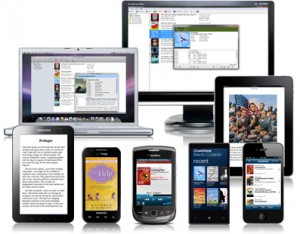Premise: all students want to text in class and will do so surreptitiously if they can, so many faculty feel the only way to keep students focused is to ban mobile device use altogether. Many blog posts and articles on texting, cell phone, or mobile device use in class seem to start with this  premise.
premise.
Responses to the growing use of devices in the classroom have ranged from that of complete control: “Put your device on the table as you enter the classroom. Pick it up when you leave” to the laissez-faire: “Students are paying the tuition. If they want to text during class and not learn, that’s their choice.”
Developing a cogent and workable mobile device policy for the classroom continues to be a challenge. The negative effects of multitasking or auto-switching are well documented and the possibility that students may be distracted by other students’ use of devices is also a consideration.
How to deal with the presence of these devices in the classroom elicits a multiplicity of responses from faculty. A quick search on the terms “cellphone, policy, syllabus” turns up a host of ways faculty are banning or limiting their use. In fact, Cortland has collected a list of mobile device policies from syllabi that might well have been titled “36 Ways to Say No.”
However, as the prevalence of these devices continues to grow many teachers are finding ways to make the use of mobile devices work for their students’ education rather than against it. Not surprisingly, these solutions tend to encourage the integration of inquiry-based or active learning practices.
Karen Eifler suggests that mobile devices can be used to capture, archive, share and use whiteboard work done in class as well as for real-time/just-in-time information gathering. (“Cell Phones in the Classroom: Is It Time to Reconsider Your Policy?”)
John Thayer explains to his students how they will be using their devices for his Geometry class and closes with “we have work to do so please take out your phone.” (“Cell Phone Policy: A Letter to My Students”)
As New York prepares to lift its ban on cellphones in schools, many K-12 teachers will be preparing their students to use these devices responsibly and effectively. John Giambalvo explains that he will be starting slowly, using various apps as appropriate. For example, he’ll be “automating exit tickets — the micro-assessments that ask students to demonstrate their learning at the end of a lesson” using the Exit Ticket app.
Whichever mobile device policy you intend to use, it is most important to communicate it clearly to your students. As the SUNY Brockport policy on use of electronic devices in the classroom warns: “It is advisable for instructors to anticipate that issues with wireless communications and electronic devices may arise and publish any restrictions in their course syllabi.”
More recently, faculty advise having a discussion with students to build the policy together. Having students contribute ideas for a policy, and especially for how infractions should be dealt with, encourages them to consider both their own practice and their role in establishing a respectful and productive classroom for all.
